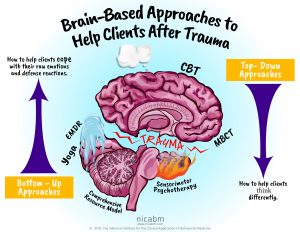Yoga: An Effective Treatment for Trauma
What exactly is trauma? Trauma is an illness of not being able to be present in the moment. It is the feeling of not having any power or control. The cause of this illness is an insidious violation to the sense of our humanity. Basically, when your lived experience left you feeling as if you had no choice in a situation that your continued life experiences continue to have flare-ups of distress in what normally and rationally before the bad event happened, you would have perceived them as non-threatening situations. As long as the trauma illness is still present you will continue living with the same pattern of distress unless you find an effective treatment for your illness. Because trauma affects the body’s physiology and because traumatic memories are stored somatically (literally within your body), researchers and clinicians are insisting that trauma treatment must incorporate the body.
In my practice with clients, when my red alarms start sounding and lighting up because I hear a series of trauma symptoms and a resistance to change through conversation I know that what is keeping a person trapped in that place and time is because they have yet to have the conversation with their body. Until the body has the conversation with me that is when authentic healing begins. Many times words are not enough and your body needs to express the way you are feeling. I then ask them to wear something comfortable the next time they have an appointment with me because we will be doing “Yoga Talk,” my personal methodology for transforming trauma into restoration of the soul. In my years of practicing as a clinician this has been the most effective and fastest way I have seen real results in healing and progress in a client’s ability to be self-reflective in the moment without getting flared-up in traumatic symptoms.
One example I can give is my Yoga Talk work with two clients (that happened to be family members) that experienced trauma. I did Yoga Talk with both of them in the room addressing feelings of shock and dissociation as well as grief. Trauma can leave a person feeling disconnected to the world and even those we love the most. The clients were struggling with the passing of their loved one and this took a toll on their relationship. A sense of anger and blame manifested between the two. By doing Yoga Talk together this method broke the barrier of feelings of dissociation in their relationship and they were able to be more in sync with one another by doing the same breath and movement techniques which created a shared experience and more importantly united healing for the shared traumatic experience. In my professional opinion I believe that if I only did talk therapy with them their progress would not have happened as quickly as it did (one month) and there would have been risk for echoing traumatic wounds.
Another example is when I had a one on one session with the widow, I had her go into Supta hasta padangusthasana, “reclined hand to big toe pose” as she was in the posture I asked her to share what was on her mind. She said this pose opened her eyes to see the way that she’s feeling, as she is generating strength into her leg muscles. She said “I feel like I am learning how to walk again, this time alone without my [loved one],” as tears rolled down her face. I told her, “You are.” It was through the yoga that she was able to be reflective of her mourning experience to connect to those sacred feelings we often protect with feelings like anger and avoidance like she had been doing when she observed her experience reactively. People can sometimes attend talk therapy for years and never access important aspects of their inner-most important experiences.
The reason for this is depicted below:
Therapeutic methods such as CBT works from the top down. It can take a long time to get to the bottom because of all the flare-ups that will happen on the way there. Constant triggering and a sense of reliving the experience will happen before being able to help someone think differently about the experience. Whereas, Yoga and my method Yoga Talk works from the bottom up. Yoga Talk starts at the bottom empowering a person to feel safe again in that sacred space to observe and reflect on traumatic memories and experiences. And then effective coping strategies can be honestly made as a way to naturally “maintain safety and vulnerability” as opposed to other methods that work from the top down that can function as a lifetime of feeling a sense of defending “safety and vulnerability.” If a feeling of defense is still present this would suggest that a feeling of fear is too.
The themes for trauma-sensitive Yoga are experiencing the present moment, making choices, taking effective action, and creating rhythms. A great way to come into the present moment is having an awareness of your breath this opens a person’s perspective on how your body and your emotions are interconnected. Trauma is an experience of having no choice. Making choices is needed for healing because it is what was missing during the trauma. Yoga offers a supportive, self-paced space for people to make choices in relation to their bodies and their experience that are kind, gentle, and compassionate, everything that was not present when the traumatic experience happened.
Traumatic situations often include the feeling where all of our energy is going toward getting away from a threat, but it is like a never-ending inability to escape. With this sense of helplessness it is important to redevelop taking effective action. Simply sitting in Sukasana, “easy pose,” by observing what you feel in your body a person can decide if they need a block to sit on or a blanket, or if they would like to switch legs. This empowers a person to take action for themselves something they couldn’t do when the trauma froze them. This empowers a person of their abilities and their options. Lastly, creating rhythm where a person feels isolated. Trauma cuts off human relationship, by recreating a synchrony between the body’s physiology and their emotions it is like turning the light back on and you can reconnect to your intuition. Maybe a person has stopped eating and is unable to sleep. Their body and mind are not in sync. When you are able to go with the flow this is the feeling of being intuitive with yourself physically and emotionally.
In summary, I encourage anyone who has PTSD, anxiety, and depression to include Yoga into your healing journey. Be quiet and let your body do the talking to liberate locked feelings that are holding you back from your true self.
Reference
EMERSON, DAVID HOPPER, ELIZABETH (2017). Overcoming Trauma Through Yoga: reclaiming your body. P
(2019, April 8). Brain-Based Approaches to Help Clients After Trauma [Infographic]. Retrieved from https://www.nicabm.com/brain-based-approaches-to-help-clients-after-trauma/



